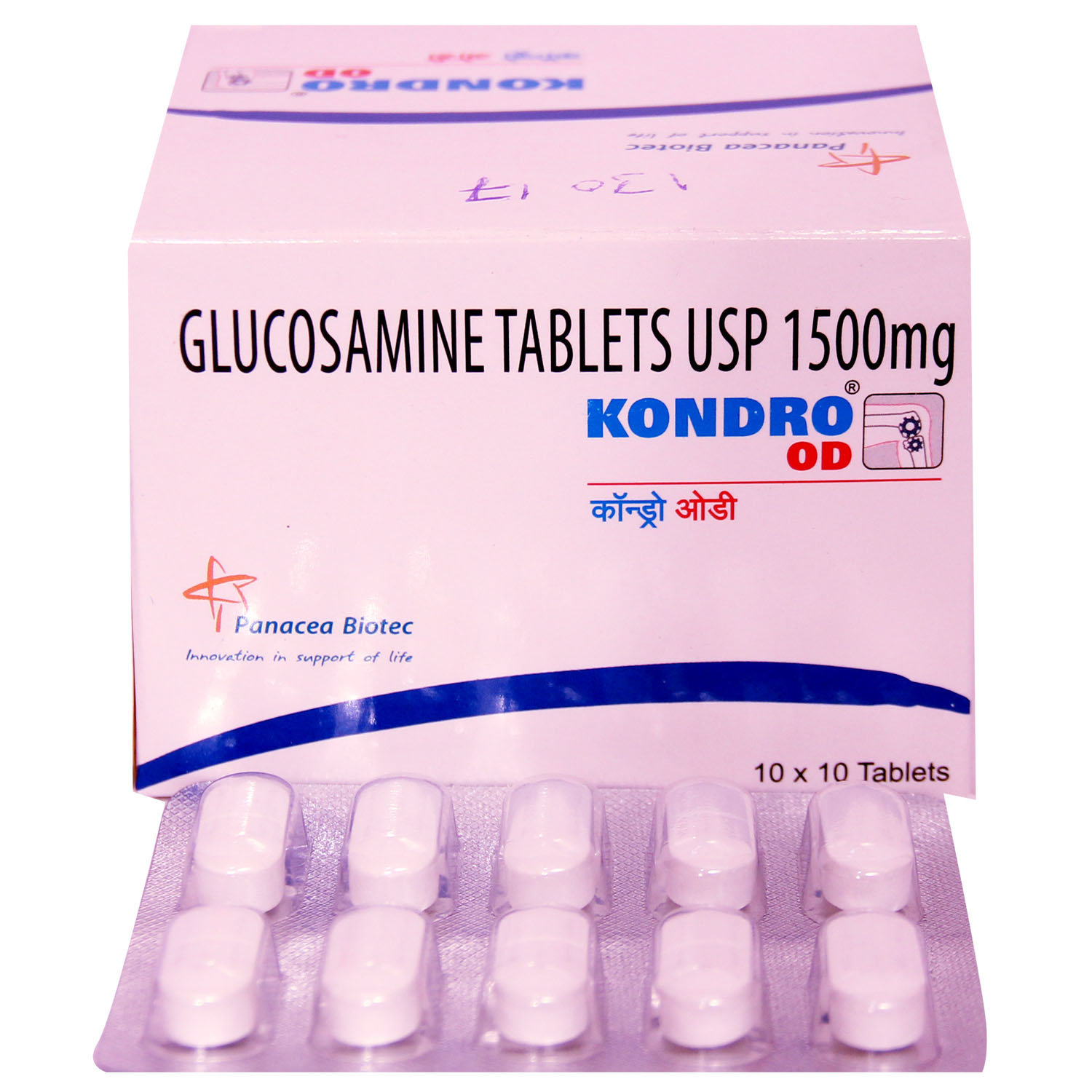Glucosamine
About Glucosamine
Glucosamine belongs to a class of medications called nutritional supplements used to reduce pain, stiffness, and swelling in joints caused by osteoarthritis. Osteoarthritis is a degenerative joint disease in which the two ends of the joints come together due to the breakdown of a protective covering of cartilage. Due to the absence of this protective covering, the joints rub against each other, leading to pain and stiffness.
The Glucosamine contains Glucosamine, which stimulates the formation and repair of the cartilage (the hard connective tissue that protects and covers the ends of long bones at the joints). It lubricates the joints and improves flexibility and movement. Thereby, reduces pain and swelling in the joints.
Take Glucosamine as advised by your doctor. In some cases, you may experience constipation, diarrhea, nausea, vomiting, or heartburn. Most of these side effects of Glucosamine do not require medical attention and gradually resolve over time. However, if the side effects persist or worsen, please consult your doctor.
If you are allergic to shellfish, Glucosamine, or any other medicines, please tell your doctor. If you are pregnant or breastfeeding, please inform your doctor before taking Glucosamine. Do not give Glucosamine to children without doctor’s advice. Avoid consumption of alcohol with Glucosamine as it may affect the way Glucosamine works. Drive only if you are alert after taking Glucosamine. You are recommended not to take more than the dose directed on the label as it may cause Glucosamine overdose.
Uses of Glucosamine
Medicinal Benefits
Glucosamine contains Glucosamine, a nutritional supplement used to reduce pain, stiffness, and swelling in joints caused by osteoarthritis. Glucosamine helps to stimulate the formation and repair of the cartilage (the hard connective tissue that protects and covers the ends of long bones at the joints). It lubricates the joints and improves flexibility and movement. Thereby, reduces pain and swelling in the joints.
Directions for Use
Storage
Side Effects of Glucosamine
- Constipation
- Diarrhea
- Nausea
- Vomiting
- Heartburn
- Rashes
Drug Warnings
If you are allergic to shellfish, Glucosamine, or any other medicines, please tell your doctor. If you are pregnant or breastfeeding, please inform your doctor before taking Glucosamine. Do not give Glucosamine to children without doctor’s advice. If you have cancer, high cholesterol, diabetes, liver disease, asthma, or other breathing problems, inform your doctor before taking Glucosamine. Avoid consumption of alcohol with Glucosamine as it may affect the way Glucosamine works. Drive only if you are alert after taking Glucosamine. If you are about to undergo any surgery, inform your doctor that you are carrying Glucosamine. You are recommended not to take more than the dose directed on the label as it may cause Glucosamine overdose and lead to adverse effects.
Drug Interactions
Drug-Drug Interaction: Glucosamine may interact with blood thinners (warfarin, dicumarol, anisindione) and anticancer agents (etoposide and doxorubicin).
Drug-Food Interaction: Glucosamine may interact with alcohol. Therefore, avoid alcohol intake while taking Glucosamine as it may affect the way Glucosamine works.
Drug-Disease Interaction: If you have cancer, high cholesterol, diabetes, liver disease, asthma or other breathing problems, inform your doctor before taking Glucosamine.
Drug-Drug Interactions Checker List:
Safety Advice

Alcohol
unsafeAvoid consumption of alcohol with Glucosamine as it may affect the way Glucosamine works. Please consult a doctor before consuming alcohol with Glucosamine.

Pregnancy
cautionPlease consult a doctor if you are pregnant. Glucosamine is given to pregnant women only if the doctor thinks benefits outweigh risks.

Breast Feeding
cautionGlucosamine may be excreted in breast milk and cause adverse effects in the baby. Therefore, Glucosamine is given to breastfeeding mothers only if the doctor thinks benefits are more significant than risks. Please consult a doctor if you are breastfeeding.

Driving
cautionDrive only if you are alert after taking Glucosamine.

Liver
cautionTake Glucosamine with caution, especially if you have a history of Liver diseases/conditions. The dose may be adjusted by your doctor as required.

Kidney
cautionTake Glucosamine with caution, especially if you have a history of Kidney diseases/conditions. The dose may be adjusted by your doctor as required.

Children
cautionGlucosamine is not recommended for children until and unless advised by a doctor.
Habit Forming
Diet & Lifestyle Advise
- Physical activity helps in strengthening muscles and relieves joint stiffness. Gentle activities like 20-30minutes of walking or swimming would be helpful.
- Performing yoga may also help in improving joint flexibility and pain management.
- Maintain a healthy weight by performing regular low-strain exercises and eating healthy food.
- Get adequate sleep as resting the muscles can help in reducing inflammation and swelling.
- Follow heat or cold therapy, apply a cold or hot compress on the joints for 15-20 minutes regularly.
- Acupuncture, massage, and physical therapy may also be helpful.
- Eat foods rich in antioxidants such as berries, spinach, kidney beans, dark chocolate, etc.
- Foods containing flavonoids such as soy, berries, broccoli, grapes, and green tea help in reducing inflammation.
- Avoid smoking and alcohol consumption.
Special Advise
Glucosamine may interact with blood sugar tests and give unusual results. Therefore, if you have diabetes, use Glucosamine only if advised by a doctor.
Patients Concern
Disease/Condition Glossary
Osteoarthritis: It is a degenerative joint disease in which the two ends of the joints come together due to the breakdown of a protective covering of cartilage. Due to the absence of this protective covering, the joints rub against each other, leading to pain and stiffness. Symptoms of osteoarthritis include pain, stiffness, inflammation, and tenderness. The main reason for osteoarthritis is age, the older you are, the more likely you could get osteoarthritis, thus known as degenerative disease, meaning that the joints wear-out as a person ages. Other reasons include a past injury such as torn cartilage, dislocated joints, and ligament injuries.
FAQs
The Glucosamine contains Glucosamine, which stimulates the formation and repair of the cartilage (the hard connective tissue that protects and covers the ends of long bones at the joints). It lubricates the joints and improves flexibility and movement. Thereby, reduces pain and swelling in the joints.
You are not recommended to take Glucosamine with warfarin as co-administration of these two medicines may increase bleeding risk more efficiently. However, if you notice unusual bleeding or bruising, blood in urine or stools, dizziness, vomiting, weakness, or headache, please consult a doctor immediately. However, please consult your doctor before taking Glucosamine with other medicines.
Glucosamine may interfere with a blood sugar test and give unusual results. Therefore, if you have diabetes, take Glucosamine only if advised by a doctor.
Glucosamine should be used with caution in asthma patients as it may worsen the condition. Therefore, please inform your doctor if you have asthma or a history of asthma before taking Glucosamine.
Glucosamine does not cure arthritis. Glucosamine is only used to relieve symptoms of arthritis such as joint pain, swelling and stiffness.
If you are about to undergo any surgery, you are recommended to inform your doctor that you are taking Glucosamine as you may be advised to stop taking Glucosamine for a short time.





